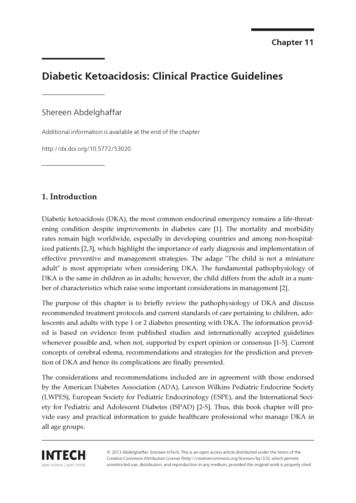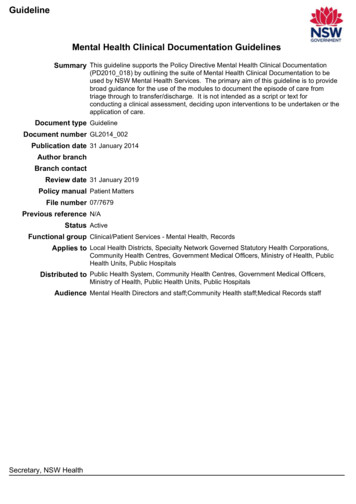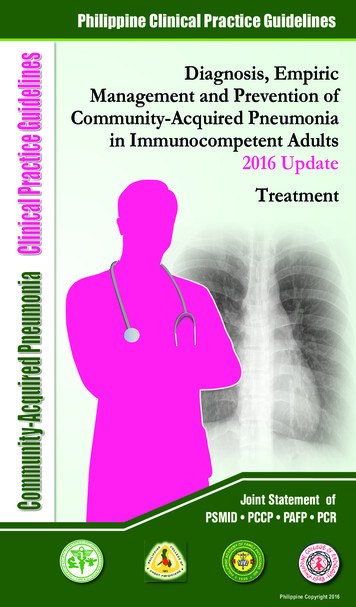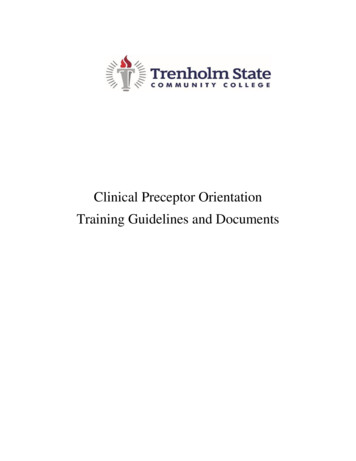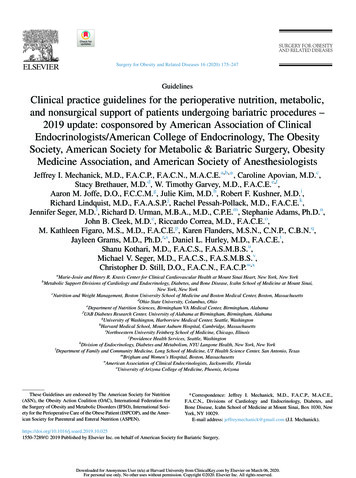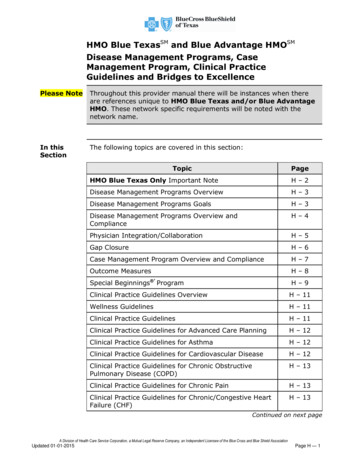
Transcription
CLINICAL GUIDELINES:ANTIRETROVIRAL THERAPY44.1Preparing people living with HIV for ART.4.2What to expect in the first months of ART.4.3When to start ART. .4.4What to start: first-line ART.4.5Monitoring the response to ART and diagnosing treatment failure. .4.6Monitoring of and substitutions for ARV drug toxicities.4.7Key ARV drug interactions.4.8What ART regimen to switch to (second- and third-line ART). . . . . . . . . . . . . . . . . . . . . . . . . . . . . . .72. . . . . . . . . . . . . . . . . . . . . . . . . . . . .74. . . . . . . . . . . . . . . . . . . . . . . . . . . . . . . . . . . . . . . . . . . . .74. . . . . . . . . . . . . . . . . . . . . . . . . . . . . . . . . . . . . . .97. . . . . . . . . . .127. . . . . . . . . . . . . . . . . . .136. . . . . . . . . . . . . . . . . . . . . . . . . . . . . . . . . . . . . . .147. . . . . . . . . . . . . . .150
72Consolidated guidelines on the use of antiretroviral drugs for treating and preventing HIV infection4 CLINICAL GUIDELINES: ANTIRETROVIRALTHERAPY4.1 Preparing people living with HIV for ARTBefore people start antiretroviral therapy (ART), health-care providers should initiate adetailed discussion about the willingness and readiness of patients to initiate ART, theantiretroviral (ARV) drug regimen, dosage, scheduling, likely benefits, possible adverseeffects and the required follow-up and monitoring visits. In the case of children with HIV,this conversation should directly involve the caregiver and include discussion aboutdisclosing their HIV status. Retesting all people living with HIV before initiating ART isrecommended to ensure a correct diagnosis of HIV infection. Initiation of ART shouldalways consider nutritional status, any comorbidities and other medications being takento assess for possible interactions, contraindications and dose adjustment.The choice to accept or decline ART ultimately lies with the person or his or her caregiver,and if they choose to defer initiation, ART can be offered again at subsequent visits. If theperson faces mental health or substance use issues or other potential barriers to ARTinitiation or adherence, appropriate support should be provided and readiness to initiateART should be reassessed at regular intervals. Community and peer support can help aperson to prepare and make the decision to start therapy.People starting treatment and carergivers should be informed that the first ART regimenoffers the best opportunity for effective viral suppression, immune recovery andconsequently clinical benefit and that successful ART requires all medications to be takenas prescribed. It is important to acknowledge that there are situations where delays instarting ART can have negative consequences, particularly for people with tuberculosis(TB) or advanced immunosuppression, who are at high risk of death. People should beadvised that many adverse effects are temporary or may be treated, and thatsubstitutions can often be made for the ARV drugs associated with adverse effects. Inpreparation for treatment initiation, it is important to assess the need for psychosocialsupport to optimize adherence. People receiving ART and caregivers should also be askedregularly about any other medications that are being taken, including herbal remediesand nutritional supplements.People commencing ART should be given advice on safer sex, including condom use andavoidance of other high-risk activities such as sharing of injecting equipment, to preventtransmitting HIV to other people.
Chapter 4: Clinical guidelines: antiretroviral therapy4.1.1 Accelerated ART initiationGood practice statementEfforts should be made to reduce the time between HIV diagnosis and ARTinitiation based on an assessment of a person’s readiness.ART initiation is often seen as a non-emergency intervention, and various approaches areused to help prepare people to begin treatment. However, there is increasing recognitionof the benefits of accelerated ART initiation, for example, in pregnant women, in order toavoid unacceptably high rates of loss to follow-up after HIV diagnosis. However, concernsremain that accelerated initiation of ART may lead people to start before they are ready,with adverse consequences for adherence and treatment outcomes.Current implementation experience of rapid ART initiation is largely derived fromexperience with option B (lifelong ART for all pregnant and breastfeeding women).Although ART initiation in these programmes is not necessarily on the same day astesting, the majority of women initiate treatment within a short space of time. Of nearly22 000 women who started ART under option B in Malawi, 17% were lost to follow-upsix months after ART initiation. Loss to follow-up was highest among women who beganART at large clinics on the day they were diagnosed with HIV (1).A systematic review (2) identified two ongoing studies that evaluated accelerated ARTinitiation, including treatment initiation on the same day as HIV diagnosis to reduce lossto follow up. The Rapid Initiation of Antiretroviral Therapy to Promote Early HIV/AIDSTreatment in South Africa (RapIT) study randomized individuals to rapid initiation versusstandard care (3). Preliminary data showed a relative risk of 1.33 of initiation of ART in 90days, with a risk difference of 24% (73% in the standard-of-care arm compared to 97%in the rapid initiation arm). The START-Streamlined Initiation trial is examiningaccelerated ART initiation in Uganda (4). START components include (i) real-time point-ofcare CD4 testing, (ii) targeted knowledge transfer to health-care workers and (iii)feedback and reporting to the clinic and providers.Findings from community consultations show that early ART initiation is acceptable, butuniversal same-day ART initiation following HIV diagnosis is considered to be challengingbecause of the wide variation in individuals’ understanding of the implications of testresults and preparedness to commence lifelong treatment (5). There is a perceiveddifference in motivation to start ART when sick compared to when healthy.While these guidelines recommend initiation of ART in all people with HIV regardless ofCD4 cell count or disease stage, and preliminary data suggest that accelerated ARTinitiation is possible, the available data are currently inadequate to support arecommendation in these guidelines in favour of same-day or otherwise accelerated ARTinitiation.73
74Consolidated guidelines on the use of antiretroviral drugs for treating and preventing HIV infectionThe following principles may inform future guidance. Treatment should be started based on a person’s informed decision to initiate ART. Interventions to remove barriers to ART initiation once an individual is diagnosed HIVpositive should be implemented. HIV programmes should promote treatment literacy among all people with HIV, includinginformation on the benefits of early treatment, the lifelong commitment required, therisks of delaying treatment and available adherence support. Care providers should be trained to support shared decision-making. Although ART initiation is rarely urgent, it may need to be expedited in certaincircumstances, such as serious ill health and for pregnant women in labour whose HIVtest result is positive.4.2 What to expect in the first months of ARTAlthough ART is a lifelong commitment, the first months of therapy are especially important.Clinical and immunological improvement and viral suppression are expected when individualsadhere to ART, but opportunistic infections (OIs) and/or immune reconstitution inflammatorysyndrome (IRIS) may develop, as well as early adverse drug reactions, such as drughypersensitivity, especially in the first three months of treatment. ART significantly decreasesmortality overall, but death rates are also highest in the first three months of ART. Thesecomplications are most common when the people starting ART already have advanced HIVdisease with severe immunodeficiency and existing coinfections and/or comorbidities, severelylow haemoglobin, low body mass index and very low CD4 cell counts or are severelymalnourished (6,7). Poor adherence in this period is also associated with the risk of earlytreatment failure and rapid development of drug resistance.4.3 When to start ART4.3.1 When to start ART in adults ( 19 years old)Recommendation ART should be initiated in all adults living with HIV,regardless of WHO clinical stage and at any CD4 cell count(strong recommendation, moderate-quality evidence). As a priority, ART should be initiated in all adults with severe or advanced HIVclinical disease (WHO clinical stage 3 or 4) and adults with CD4 count 350 cells/mm3 (strong recommendation, moderate-quality evidence).Sources :Guideline on when to start antiretroviral therapy and on pre-exposure prophylaxis for HIV. Geneva: World Health Organization2015 e-arv/en).Consolidated guidelines on the use of antiretroviral drugs for treating and preventing HIV infection: recommendations for a publichealth approach Geneva: World Health Organization; 2013 nload/en).
Chapter 4: Clinical guidelines: antiretroviral therapyBackgroundSince they were first published in 2002, WHO guidelines on ART have evolved as the bodyof evidence to support earlier initiation of ART has grown (8). The 2013 WHO ARVguidelines recommended initiating ART for all adults with HIV and a CD4 count at orbelow 500 cells/mm3, regardless of WHO clinical stage, giving priority to those withsevere or advanced HIV disease (WHO clinical stage 3 or 4) or a CD4 cell count at orbelow 350 cells/mm3 (9). This strong recommendation was based on moderate-qualityevidence from three randomized controlled trials (10–12) and 21 observational studies(13–34), showing that initiating ART at or below a CD4 threshold of 500 cells/mm3compared with later initiation reduced the risk of progression to AIDS and/or death, TBand a non-AIDS-defining illness and increased the likelihood of immune recovery. Inaddition, high-quality evidence from one randomized controlled trial indicated thatearlier ART can markedly reduce the risk of sexual transmission to HIV-negative sexualpartners in heterosexual couples (11).Mathematical models and ecological studies also suggested that initiating ART earliercould affect HIV incidence at the population level if there is high uptake and sustainedHIV testing, ART coverage and retention (35–39). For people with certain clinicalconditions – TB, hepatitis B virus (HBV) coinfection requiring HBV treatment and duringpregnancy and breastfeeding – and for HIV-serodiscordant couples, the 2013 guidelinesrecommended initiating ART regardless of WHO clinical stage or at any CD4 cell count.Global ART coverage for all people living with HIV had reached approximately 41% – or15 million people – by March 2015 (40). According to the WHO Country IntelligenceDatabase, by June 2014, 60% of the 58 WHO HIV focus countries had adopted the CD4threshold of 500 cells/mm3 or less for initiating ART and 7% had already moved the CD4threshold to above 500 cells/mm3 (41). Although the median CD4 count at the time of ARTinitiation is increasing, it remains significantly lower than 350 cells/mm3 in almost allsettings, including high-income countries (42,43). Late presentation for treatment isassociated with high early mortality rates, higher direct health-care costs and poorretention in care (44–46). Increasing knowledge of HIV status, strengthening linksbetween testing and care, modifying health systems to manage patient volumes andensuring optimal long-term retention and adherence remain significant challenges inmany settings (47).Rationale and supporting evidenceInitiating ART among all adults living with HIV regardless of WHO clinical stageor at any CD4 cell countSince 2013, evidence and programmatic experience have continued to favour earlierinitiation of ART because it results in reduced mortality, morbidity and HIV transmissionoutcomes. Increasing evidence from systematic reviews and cohort analyses alsoindicates that untreated HIV infection may be associated with the development of severalnon-AIDS-defining conditions, including cardiovascular, kidney and liver disease, severaltypes of cancer and neurocognitive disorders (48–51), and that initiating ART earlierreduces such events and improves survival. Recent evidence from a large randomizedcontrolled trial also shows that, as demonstrated for heterosexual serodiscordantcouples, ART substantially reduces sexual transmission to HIV-negative sexual partnersamong homosexual couples (52).75
76Consolidated guidelines on the use of antiretroviral drugs for treating and preventing HIV infectionThe recommendation to initiate ART at any CD4 cell count was based on a systematicreview with Grading of Recommendations, Assessment, Development and Evaluation(GRADE) evidence profiles that assessed the quality and strength of the evidence from onerandomized controlled trial (53) and 17 observational studies (18,19,22–26,28,30,34,37,54–59)reporting clinical, immunological) reporting clinical, immunological and virologicaloutcomes and HIV transmission.In the analysis of data from the single randomized controlled trial (TEMPRANO),moderate-quality evidence (downgraded from high quality because of imprecision)showed that initiating ART at a CD4 cell count above 500 cells/mm3, in the absence ofother treatment indications, leads to less severe HIV morbidity (combined outcome ofdeath, AIDS and severe non-AIDS diseases such as malignancies and bacterial diseases)compared with treatment initiation at a CD4 cell count at or below 500 cells/mm3 (53).Data from another randomized controlled trial (START study), although supportive of thenew recommendations, were unpublished at the time of the Clinical GuidelineDevelopment Group meeting for these guidelines (60). The START study was planned forcompletion in
4.3 When to start ART 4.3.1 When to start ART in adults ( 19 years old) Recommendation RT should be initiated in all adults living with HIV, A regardless of WHO clinical stage and at any CD4 cell count (strong recommendation, moderate-quality evidence). As a priority, ART should be initiated in all adults with severe or advanced HIV clinical disease (WHO clinical stage 3 or 4) and .





